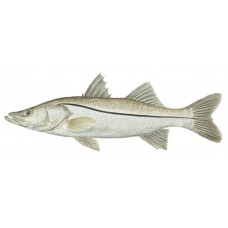Latin name
Centropomus undecimalis
Other names
Linesider, robalo, sergeant fish, snook; Portuguese: robalo; Spanish: robalo, robalito.
Identification
A silvery fish with a yellow-green or olive hue, it has a streamlined and slender body with a distinct black lateral line running from the top of the gills to the end of the forked tail. It has a sloping forehead, a long, concave snout, and a large mouth with brush-like teeth and a protruding lower jaw. The fins are sometimes bright yellow, although the pelvic fin is usually pale, unlike the orange-yellow pelvic fin with black ends in the tarpon snook. The common snook has a tall, split dorsal fin, as well as fine scales running 70 to 77 along the lateral line to the base of the tail. It has relatively short anal spines that do not reach the base of the tail when pressed against the body. The anal fin typically has 6 soft rays. There are also 15-16 rays in the pectoral fins and 7-9 gill rakes on the first arch.
Distribution
In the western Atlantic Ocean, the common snook is found mainly in the southern part of Florida, as well as off the southeastern coast of the Gulf of Mexico. Sometimes found off the coast of North Carolina and Texas. The largest snook in Florida, exceeding 30 pounds, they are caught mostly in the bays and coves of the east coast from Vero Beach south to Miami. Their populations are most abundant on the west coast from Boca Grande southward throughout the Everglades region, including Florida Bay. The Pacific black snook's range is in the eastern Pacific Ocean, mostly from Baja California, Mexico, to Colombia. The Pacific white snook range is similar and extends from Baja California to Peru.
Habitat
Snook lives in warm, shallow coastal waters and unable to tolerate fresh and salt water. They are most commonly found along continental shores, preferring rapidly changing tides and taking refuge in estuaries, lagoons, mangroves, and brackish streams, as well as freshwater canals and rivers, usually less than 65 feet deep. Occasionally, they are found in small groups on grassy shoals and shallow reefs, and can be found at the mouths of tributaries and on the ocean side of banks near tributaries. Snook cannot tolerate water temperatures below 60 °F. In winter, it stays in sheltered areas with stable temperatures under bridges, in shipping channels, in turning basins, in warm water outflows near power plants, and in upstream estuaries.
Size
The Common snook grows much larger than other snook of the Atlantic range, averaging 11⁄2 to 21⁄2 feet and 5 to 8 pounds, although it can reach 4 feet and 50 pounds. Females are almost always larger than males, although growth rates vary. The world record for all tackle is held by a 53-pound, 10-ounce fish caught off eastern Costa Rica in 1978. Common snook can live more than 20 years.
Life history and Behavior
During the spawning season, sommon snook congregate at the mouths of passages and rivers, returning to the same spawning grounds each summer. Spawning grounds include significant passages and bays in the Atlantic Ocean and Gulf of Mexico, such as the Sebastian, Ft. Pierce, St. Lucie, Jupiter, and Lake Worth on the east coast and the passages of Hurricane, Clearwater and Jones on the west coast. Common snook also spawns in Tampa Bay around the passages to the secondary waterfronts of Mikel Bay, Terra Seia Bay and Riviera Bay. The season runs from April through November, but activity peaks between May and July. More intensive spawning occurs during a new or full moon.
Food and feeding habits
Carnivorous predators that ambush their prey when currents carry food into their vicinity. They feed on both freshwater and saltwater fish, shrimp, crabs, and larger crustaceans.
Reproduction
Early in the season, the female may hatch more than 1.5 million eggs daily, and the larvae drift for 15-20 days after hatching. Young fish remain in quiet, secluded upper estuaries streams until they reach sexual maturity, which males reach in 2-3 years and females in 3-4 years. Common snook are protandric hermaphrodites - they can change their sex from male to female. This change usually occurs between the ages of 2 and 7 years, with a length of 17 to 30 inches. In the common snook group, the sex change occurs when the size of the individuals changes, that is, if the group that lost the largest fish lost females, some males may change sex to make up for their absence, a process that takes 60 to 90 days.
| Classification | |
| Phylum | Chordata |
| Class | Actinopterygii |
| Squad | Perciformes |
| Family | Centropomidae |
| Genus | Centropomus |
| Species | C. undecimalis |
| Features | |
| Conservation status | Least Concern |
| Habitat | Littoral |
| Life span, years | No information |
| Maximum body weight, kg | 24.32 |
| Maximum length, cm | 140 |
| Sailing speed, m/s | No information |
| Threat to people | Edible |
| Way of eating | Predator |



